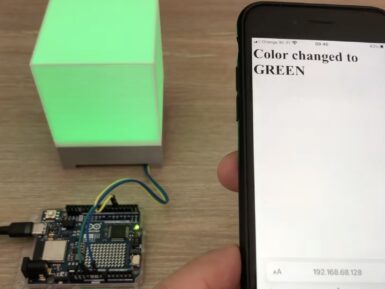
Overview
The Arduino Starter Kit Classroom Pack is a bundled solution, containing six of the popular Arduino Starter Kits.
This Classroom 6-Pack is for a classroom of at least twelve students — the recommended ratio is two students per kit — and intended for use starting from middle school teachers onwards, looking for an extensive educational solution for learning how to use the Arduino platform.
Each kit contains an Arduino Uno Rev 3 board, a collection of sensors and actuators, and — most important — a guide book which will help students and teachers to take their first steps into the world of electronics, with interactive and sensing objects.
Each Arduino Starter Kit contains a full color 170-page book with instructions for fifteen projects:
01. GET TO KNOW YOUR TOOLS: An introduction to the basics.
02. SPACESHIP INTERFACE: Design a control panel for a starship.
03. LOVE-O-METER: Measure how hot-blooded you are.
04. COLOR MIXING LAMP: Produce any color with a lamp that uses light as an input.
05. MOOD CUE: Let people know how you're doing.
06. LIGHT THEREMIN: Create a musical instrument you play by waving your hands.
07. KEYBOARD INSTRUMENT: Play music with this keyboard.
08. DIGITAL HOURGLASS: A light-up hourglass that can stop you from working too much.
09. MOTORIZED PINWHEEL: A colored wheel that will make your head spin.
10. ZOETROPE: Create a mechanical animation you can play--and in reverse.
11. CRYSTAL BALL: A mystical tour to answer all your tough questions.
12. KNOCK LOCK: Unlock a door with a secret knock.
13. TOUCHY-FEELY LAMP: A lamp that responds to your touch.
14. TWEAK THE ARDUINO LOGO: Control your personal computer from your Arduino.
15. HACKING BUTTONS: Create a master control for all of your devices!
Tech specs
Each Starter Kit includes:
1 Projects Book (170 pages), 1 Arduino Uno, 1 USB cable, 1 Breadboard 400 points, 70Solid core jumper wires, 1 Easy-to-assemble wooden base, 1 9v battery snap, 1 Stranded jumper wires (black), 1 Stranded jumper wires (red), 6 Phototransistor, 3 Potentiometer 10kOhms, 10Pushbuttons, 1 Temperature sensor [TMP36], 1 Tilt sensor, 1 alphanumeric LCD (16x2 characters), 1LED (bright white), 1 LED (RGB), 8 LEDs (red), 8 LEDs (green), 8 LEDs (yellow), 3 LEDs (blue), 1 Small DC motor 6/9V, 1 Small servo motor, 1 Piezo capsule [PKM17EPP-4001-B0], 1 H-bridge motor driver [L293D], 1 Optocouplers [4N35], 2 Mosfet transistors [IRF520], 5 Capacitors 100uF, 5 Diodes [1N4007], 3 Transparent gels (red, green, blue), 1 Male pins strip (40x1), 20 Resistors 220 Ohms, 5Resistors 560 Ohms, 5 Resistors 1 kOhms, 5 Resistors 4.7 kOhms, 20 Resistors 10 kOhms, 5Resistors 1 MOhms, 5 Resistors 10 MOhms
Conformities
Resources for Safety and Products
Manufacturer Information
The production information includes the address and related details of the product manufacturer.
Arduino S.r.l.
Via Andrea Appiani, 25
Monza, MB, IT, 20900
https://www.arduino.cc/
Responsible Person in the EU
An EU-based economic operator who ensures the product's compliance with the required regulations.
Arduino S.r.l.
Via Andrea Appiani, 25
Monza, MB, IT, 20900
Phone: +39 0113157477
Email: support@arduino.cc
Get Inspired

Syntaxx is powered by three Arduino boards, each handling specific functions to create a seamless and dynamic performance:

It can be tough to get started with building an Internet of Things (IoT) project from the ground-up, as getting connected, serving a webpage, and managing other devices can all be a challenge to a beginner. This is why the YouTuber known as “Mario’s Ideas” made an end-to-end tutorial that details everything one might need to build a smart RGB lamp. Because the Arduino UNO R4 WiFi contains an ESP32-S3 chip for its Wi-Fi radio and Renesas RA4M1 microcontroller, it was the perfect candidate. Mario’s sketch begins with a call to initialize the Wi-Fi module before attempting to connect to his local access point. Once finished, it enters a loop that continuously checks if a client has connected to the web server, and if one has, reads the requested path while also seeing if the string contains “/H” to denote an “ON” command to set the LED. Toggling an LED is useful, but Mario wanted to take things a step further by building a tangible — in this case a lamp. His 3D-printed enclosure features a recessed base and translucent cube for diffusing the light emitted by a grid of NeoPixels. Controlling the color was just as easy since any browser could still send a request path containing a color and get back the lamp’s updated status. To see more about this IoT lamp project, you can watch Mario’s video below!









